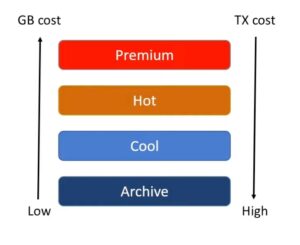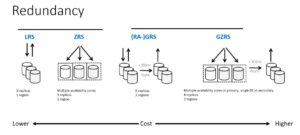- Solutions
- Overview
- Rapid Response Cloud Cost Rescue
- Cloud Internal Cost Management (FinOps) Assessment
- Cloud Supplier Cost Management (FinOps) Assessment
- Cloud Cost Saving
- Cloud Cost Avoidance
- Cloud Billing, Cross Charging & Contract Management
- FinOps Enablement
- FinOps Training & Learning
- FinOps Tool Selection & Implementation
- Service Models
- Ways of Working
- Resources
- About
- Contact Us

Azure- Optimising BLOB storage
16/06/2021
Azure Storage
This Blog focuses on BLOB storage, through the lens of FinOps and cloud cost optimization. Future Blogs will focus on file-based storage and optimization opportunities of this storage type.
For customers running IaaS, behind compute, the largest source of cloud cost and cloud wastage is typically storage. In Azure, storage can be broadly broken down into three categories:
- Azure BLOB – typically used for backups and to manage general data (individual files can be up to 500TB in Size!)
- Azure Files – Storage used to host application data – for example, Azure Files would host a Database.
- Azure Data Lake – Stores complex data typically used for analytics and big data analysis.
Azure BLOB Storage
Azure BLOB storage is used to store unstructured data, typically in very large amounts. BLOBS are organised into containers (no, not like Kubernetes!), and each Azure Account can have an unlimited number of containers. BLOBS must reside in a container. You can purchase Azure BLOB Storage reserved capacity in units of 100 TB and 1 PB per month for a one-year or three-year term. This can provide up to 38% discount off the on-demand rates for some storage tiers.
Azure BLOB Storage Access Tiers
There are 4 tiers of BLOB storage:
- Premium. This tier is ideal for sensitive applications with high throughput such as online transactions. Uniquely amongst the big 3 public cloud vendors, Azure Premium BLOB storage is based on SSD’s.
- Hot. This is the default tier and is used for data that is frequently accessed. It is more expensive to store data here, compared to the Cool and Archive tiers, but cheaper to access.
- Cool. This tier is used for storing less frequently accessed data, such as archived files, backups, and raw or unprocessed data. Cool is designed for data that is likely to be stored for at least 30 days.
- Archive. This is the most cost-effective option for storing data but is typically more expensive for data retrieval than other tiers. Archive is designed for data that is likely to be stored for at least 180 days, and for systems or scenarios where retrieval latency can be tolerated.

*Adapted from Azure Fridays
Azure BLOB Redundancy
Another big factor that influences BLOB storage costs relates to redundancy. Azure offers 4 different redundancy models. The more replicas and regions, the more it costs.

More information about redundancy here.
Azure BLOB Lifecycle Policy
From a cost management perspective, the most important BLOB lifecycle management policies allow a customer to:
- Transition BLOBS, to a cooler storage tier (hot to cool, hot to archive, or cool to archive) if not accessed or modified for a period of time to optimize for cost.
- Delete blobs, blob versions, and blob snapshots at the end of their lifecycles.
- Define rules to be run once per day at the storage account level.
In Conclusion
To make informed decisions about BLOB requirements, comprehensive knowledge of the applications utilising it is needed. Unlike Azure compute resources, the recommendations offered by Azure Adviser can be limited and not much help.
BLOB Storage can make up a significant portion of customer cloud spend and can also be a large component of cloud wastage. There are several factors that customers need to be conscious of to ensure that they are not throwing away money.
Here are some recommendations to reduce and eliminate cloud wastage relating to BLOB storage:
- Use reservations where possible.
- Ensure that you use the most appropriate tier of storage based on the applications data requirements.
- Ensure that you select the most appropriate redundancy based on your business’s requirement – i.e., is Geo-zone-redundant storage (GZRS), which copies your data synchronously across three Azure availability zones, really needed for a Training Systems backup?
- Implement a BLOB lifecycle policy to transition data to cheaper storage tiers when data access requirements reduce.
- Plan regular storage reviews with the application owners and adjust.
Let FinAnts help you optimize your Azure BLOB storage costs
Contact us:
- For Americas – [email protected]
- For rest of world – [email protected]






